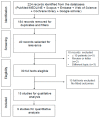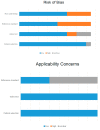18F-Facbc in Prostate Cancer: A Systematic Review and Meta-Analysis
- PMID: 31514479
- PMCID: PMC6769578
- DOI: 10.3390/cancers11091348
18F-Facbc in Prostate Cancer: A Systematic Review and Meta-Analysis
Abstract
Trans-1-amino-3-18F-fluorocyclobutanecarboxylic-acid (anti-[18F]-FACBC) has been approved for the detection of prostate cancer (PCa) in patients with elevated prostate-specific-antigen following prior treatment. This review and meta-analysis aimed to investigate the diagnostic performance of 18F-FACBC positron emission tomography/computed-tomography (PET/CT) in the detection of primary/recurrent PCa. A bibliographic search was performed including several databases, using the following terms: "FACBC"/"fluciclovine" AND "prostate cancer"/"prostate" AND "PET"/"Positron Emission Tomography". Fifteen and 9 studies were included in the systematic reviews and meta-analysis, respectively. At patient-based analysis, the pooled sensitivity and specificity of 18F-FACBC-PET/CT for the assessment of PCa were 86.3% and 75.9%, respectively. The pooled diagnostic odds-ratio value was 16.453, with heterogeneity of 30%. At the regional-based-analysis, the pooled sensitivity of 18F-FACBC-PET/CT for the evaluation of primary/recurrent disease in the prostatic bed was higher than in the extra-prostatic regions (90.4% vs. 76.5%, respectively); conversely, the pooled specificity was higher for the evaluation of extra-prostatic region than the prostatic bed (89% vs. 45%, respectively). 18F-FACBC-PET/CT seems to be promising in recurrent PCa, particularly for the evaluation of the prostatic bed. Additional studies to evaluate its utility in clinical routine are mandatory.
Keywords: 18F-FACBC; PET/CT; meta-analysis; prostate cancer; recurrence; review.
Conflict of interest statement
The authors declare no conflict of interest.
Figures
References
-
- Bruce J.Y., Lang J.M., McNeel D.G., Liu G. Current controversies in the management of biochemical failure in prostate cancer. Clin. Adv. Hematol. Oncol. 2012;10:716–722. - PubMed
-
- Roehl K.A., Han M., Ramos C.G., Antenor J.A.V., Catalona W.J. Cancer progression and survival rates following anatomical radical retropubic prostatectomy in 3478 consecutive patients: Long-term results. J. Urol. 2004;172:910–914. doi: 10.1097/01.ju.0000134888.22332.bb. - DOI - PubMed



